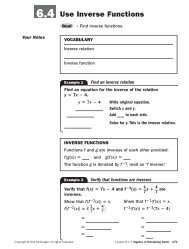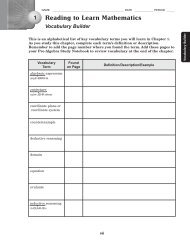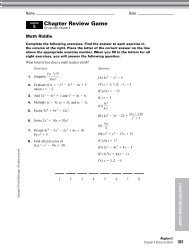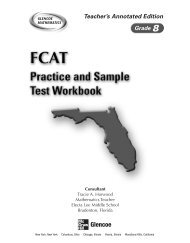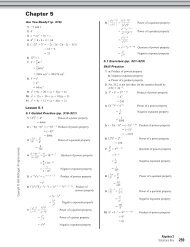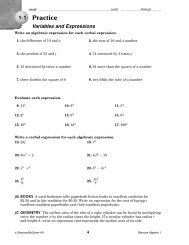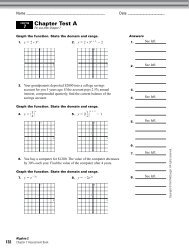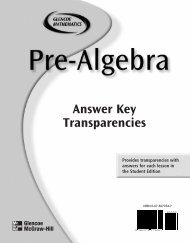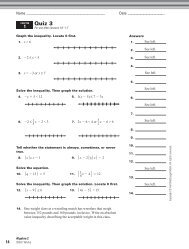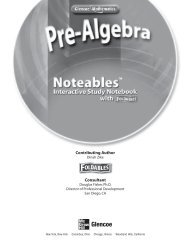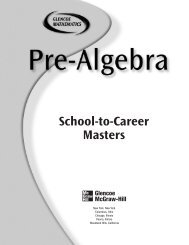Study Guide and Intervention (continued) - MathnMind
Study Guide and Intervention (continued) - MathnMind
Study Guide and Intervention (continued) - MathnMind
Create successful ePaper yourself
Turn your PDF publications into a flip-book with our unique Google optimized e-Paper software.
14-5<br />
NAME ______________________________________________ DATE______________ PERIOD _____<br />
<strong>Study</strong> <strong>Guide</strong> <strong>and</strong> <strong>Intervention</strong><br />
Probability Simulations<br />
Theoretical <strong>and</strong> Experimental Probability The probability used to describe<br />
events mathematically is called theoretical probability. For example, the mathematical<br />
1<br />
1<br />
probability of rolling a 4 with a number cube is , or P(4) . Experimental probability<br />
6<br />
6<br />
is the ratio of the number of times an outcome occurs in an experiment to the total number<br />
of events or trials, known as the relative frequency.<br />
Experimental probability<br />
Example 1<br />
Matt recorded that it rained 8 times in November <strong>and</strong> snowed<br />
3 times. The other days, it was sunny. There are 30 days in November. Suppose<br />
Matt uses these results to predict November’s weather next year. What is the<br />
probability that a day in November will be sunny?<br />
frequency of outcome<br />
Experimental Probability <br />
total number of trials<br />
(30 8 3)<br />
<br />
30<br />
19<br />
63.3%<br />
30<br />
The probability that it will be sunny on a day in November is 63.3%.<br />
Example 2<br />
A football team noticed that 9 of the last 20 coin tosses to choose<br />
which team would receive the ball first resulted in tails. What is the experimental<br />
probability of the coin l<strong>and</strong>ing on tails? What is the theoretical probability?<br />
frequency of outcome<br />
Experimental Probability <br />
total number of trials<br />
number of tails<br />
<br />
total number of tosses<br />
9<br />
45%<br />
20<br />
In this case, the experimental probability that a coin toss will be tails is 45%. If the coin is<br />
fair, the mathematical probability is 50%<br />
Exercises<br />
frequency of an outcome<br />
<br />
total number of trials<br />
A math class decided to test whether a die is fair, that is, whether<br />
the experimental probability equals the theoretical probability.<br />
The results for 100 rolls are shown at the right. Use the<br />
information for Exercises 1–3.<br />
1. What is the theoretical probability of rolling a 6?<br />
2. What is the experimental probability of rolling a 6?<br />
3. Is the die fair? Explain your reasoning.<br />
1: 1 2: 15<br />
3: 4 4: 13<br />
5: 15 6: 42<br />
© Glencoe/McGraw-Hill 855 Glencoe Algebra 1<br />
Lesson 14-5



